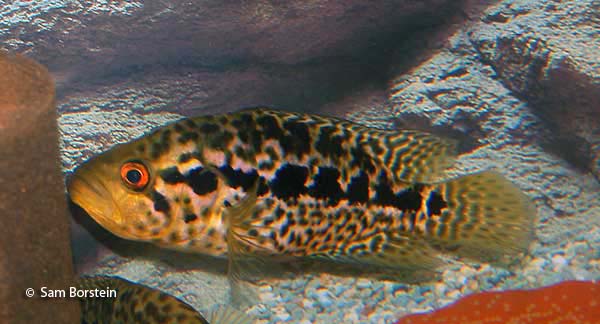Parachromis managuensis
(Günther, 1866)
Jaguar Cichlid, Jags, Managua Cichlid
Synonyms: Cichlasoma managuensis

Above: A male Jaguar Cichlid. Photo by Sam Borstein.
Etymology:
Genus- Para= side (Greek), chromis= a fish, perhaps a perch (Greek).
Species-managuensis= named after type locality Lago Managua in Nicuragua.
Intro:
Parachromis managuensis, more commonly known as the Jaguar Cichlid, is one of the most popular cichlids in the fishkeeping hobby. First typed in 1867 by Gunther, the fish has been known to science for quite some time, with the type locality coming from Lago Managua.
This fish, along with Oscars, Red Devils, and Dovii, is one of the most popular tank busters for a few reasons. They are beautiful, active, and have an interesting personality.
Distribution:
The Jaguar Cichlid is native to Costa Rica, Honduras, and Nicaragua and can be found in turbid waters of lakes and rivers over a muddy substrate.
Size, Maturity, and Sexual Dimorphism:
Size: Males- 16 inches, Females- 14 inches
Maturity: 5 inches
Sexual Dimorphism: Males are a little bit larger than females and have longer fin extensions. Males also tend to have heavy amounts of spotting on their face.
Care:
The Jaguar Cichlid can be (usually is!) aggressive. Although they will usually do fine with similarly sized fish with a like disposition, they can turn quickly on each other, and tankmates, so be cautious. If keeping a pair try to put in some decorations that only the female can fit in so she has some refuge. Sometimes it's a good idea to use a tank divider when keeping pairs.
Like most large fish, Jaguars create a lot of waste, so you must keep up on water changes and have strong filtration. One-third to one-half of the tank water should be changed weekly. Beware of aggressive behavior immediately after a water change.
Temperatures should be 76F to 80F and my fish did fine in hard, alkaline water.
Diet:
Jaguar Cichlids are predators in the wild, so feed what you would to a typical carnivore. Tetra Cichlid Sticks and Spectrum will keep the fish in a good condition. They especially like blood worms and earth worms, and will go crazy for live fish, although they are not a required part of the diet.
Breeding:
Jaguars are pretty easy to breed once you get a pair. The key is keeping the female in condition and managing aggression between the male and female, as males can turn on females quickly.
The fish get very intensely colored during spawning. Anywhere from 150 to 1000 eggs can be laid depending on age and size of the fish. The eggs take about four days to hatch and by ten days the fry are free swimming. Parents are usually very good at raising the fry. The fry grow quickly and can be first fed baby brine shrimp, then crushed flake.

Above: A male Jaguar Cichlid on eggs. Photo by Sam Borstein.
Conclusion:
This is a classic tank buster and is easily attainable. If you like big cichlids, you have to try these guys as they are classic in the hobby. You can usually find them at pet shops and local hobbyists are guaranteed to have some.
References:
- Günther, A. (1867) Memoir on the Fishes of the States of Central America, founded upon specimens collected in the fresh and marine waters of various parts of that country by Messrs. Salvin and Godman and Capt. J.M. Dow. Proceedings of the Zoological Society of London, 1866, 600–604.
